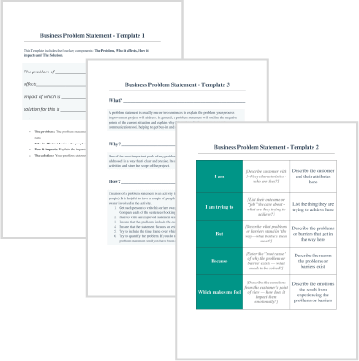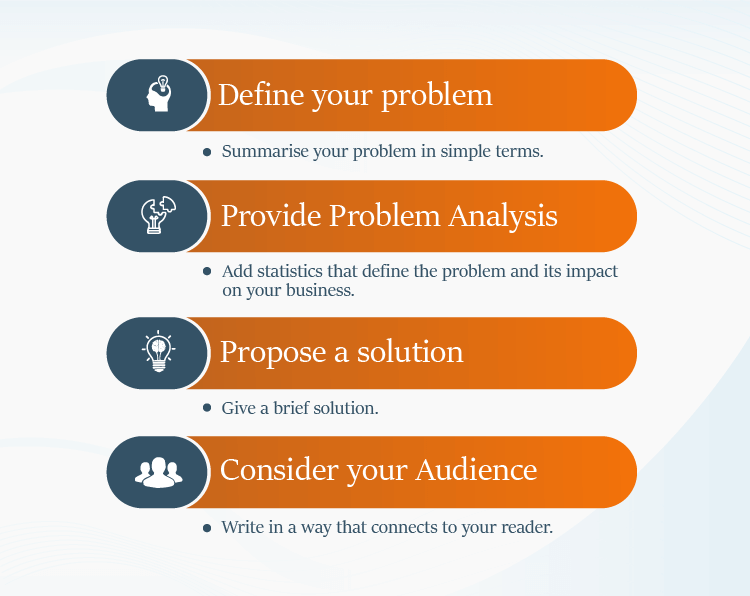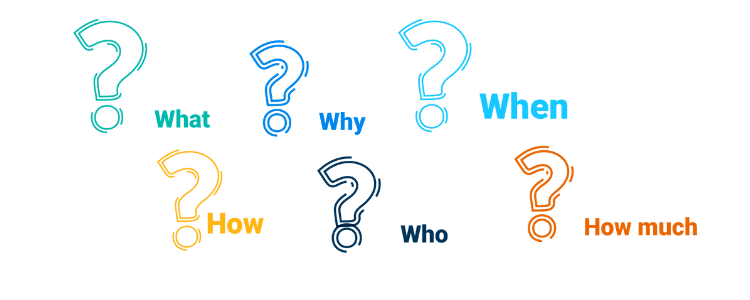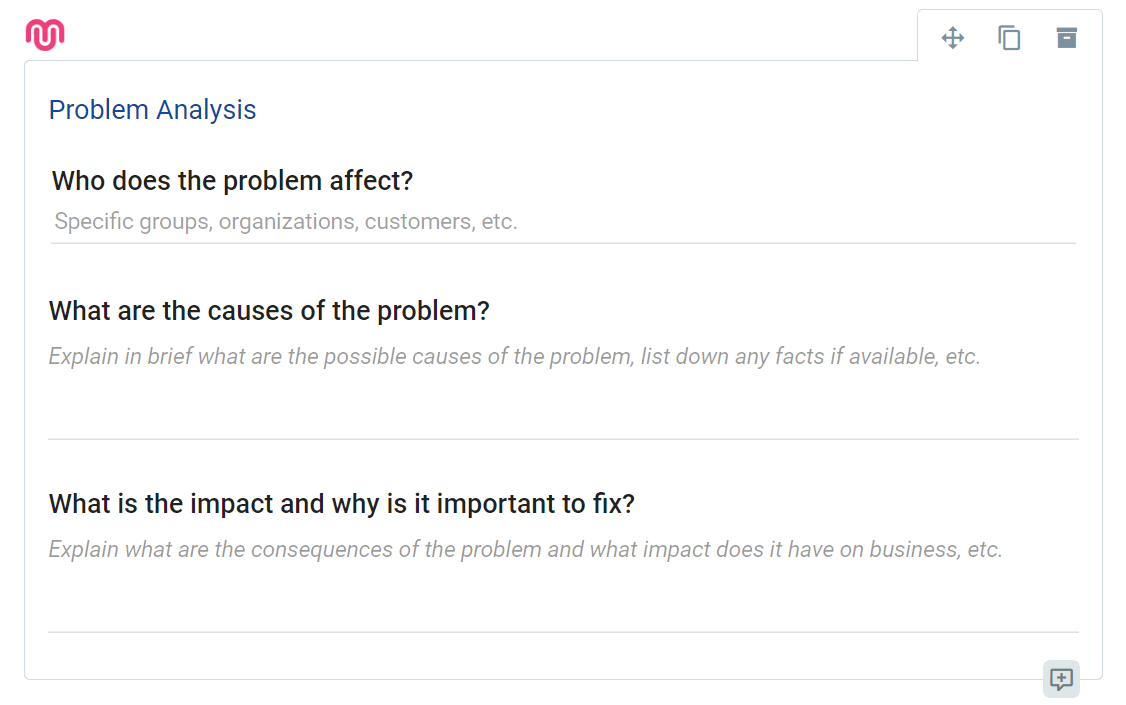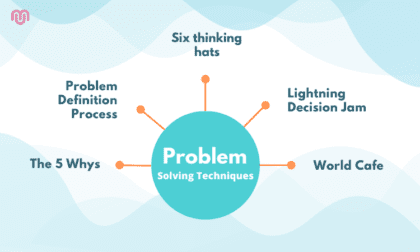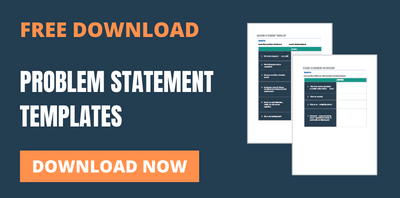Running a business is an extremely tedious task. Almost always, there’s a problem or two that needs your immediate attention, and addressing these problems head-on to find their solutions is a part of the process. Luckily, there’s a tool that can help you with that: a business problem statement.
You may know how necessary it is to write a business plan for your company. What you may not know of, however, are the tools and techniques that can help you solve your business problems.
A business problem statement can help analyze the problem and come up with new and creative ways to solve it.
Essentially, it enables you to approach the problem in a more systematic, measurable, and objective way.
-
What is a business problem statement?
-
How to write a business problem statement?
-
Business problem statement framework
-
Business problem statement templates
-
Business problem statement example
In this article, we will see what is a business problem statement and how you can write one yourself.
What Is a Business Problem Statement?
It defines the problem that a company is facing. Also, it involves an intricate analysis of the problem, details relevant to the situation, and a solution that can solve the problem. This is a simple yet effective way to present a problem and its solution concisely.
In other words, it is a communication tool that helps you visualize and minimize the gap between what’s ideal vs. what’s real. Or to put it in business lingo, the expected performance, and the real performance.
A business problem statement is a compact communication tool that helps you convey what you want to change.
How to Write a Business Problem Statement?
Before writing a business problem statement, it is crucial to conduct a complete analysis of the problem and everything related. You should have the knowledge to describe your problem and also suggest a solution to it.
To make things easy for you, we have explained the four key aspects to help you write your business problem statement. They include:
-
Define the problem
Defining the problem is the primary aspect of a business problem statement. Summarize your problem in simple and layman terms. It is highly recommended to avoid industrial lingo and buzzwords. Write a 3-5 sentences long summary, avoid writing more than it.
-
Provide the problem analysis
Adding statistics and results from surveys, industry trends, customer demographics, staffing reports, etc., helps the reader understand the problem distinctly. These references should describe your problem and its effects on various attributes of your business.
Avoid adding too many numbers in your problem statement, and include only the absolute necessary statistics. It’s best to include not more than three significant facts.
Don’t mention numbers in your problem statement if they are irrelevant to the situation. -
Propose a solution
Your business problem statement should conclude with a solution to the problem that was previously described. The solution should describe how the current state can be improved.
Solutions must not exceed than two sentences.Avoid including elaborate actions and steps in a problem statement. These can be further explained when you write a project plan.
-
Consider the audience
When you start writing your business problem statement, or any formal document, it is important to be aware of the reader. Write your problem statement keeping in mind the reader’s knowledge about the situation, requirements, and expectations.
Although intuitive knowledge does have its place, it is wiser to first consider and mention the facts you have learned based on your research and propose solutions accordingly.
If the readers don’t know the context of the problem, make sure to introduce it to them first before proceeding with the proposed solutions.
How to Develop a Business Problem Statement
A popular method that is used while writing a problem statement is the 5W2H (What, Why, Where, Who, When, How, How much) method. These are the questions that need to be asked and answered while writing a business problem statement.
Let’s understand them in detail.
- What: What is the problem that needs to be solved? Include the root cause of the problem. Mention other micro problems that are connected with the macro ones.
- Why: Why is it a problem? Describe the reasons why it is a problem. Include supporting facts and statistics to highlight the trouble.
- Where: Where is the problem observed? Mention the location and the specifics of it. Include the products or services in which the problem is seen.
- Who: Who is impacted by this problem? Define and mention the customers, the staff, departments, and businesses affected by the problem.
- When: When was the problem first observed? Talk about the timeline. Explain how the intensity of the problem has changed from the time it was first observed.
- How: How is the problem observed? Mention the indications of the problem. Talk about the observations you made while conducting problem analysis.
- How much: How often is the problem observed? If you have identified a trend during your research, mention it. Comment on the error rate and the frequency and magnitude of the problem.
Business Problem Statement Framework
A problem statement consists of four main components. They are:
- The problem: The problem statement begins with mentioning and explaining the current state.
- Who it affects: Mention the people who are affected by the problem.
- How it impacts: Explain the impacts of the problem.
- The solution: Your problem statement ends with a proposed solution.
Business Problem Statement Templates
Below is a common template used for writing a problem statement. It includes the four key components mentioned in the above framework.
Template 1:
Template 2:
Business Problem Statement Examples
Here are a few problem statement examples to help you understand how to write your business problem statement:
Example 1: A problem statement by a software company
The problem of a manual auditing process affects the finance department and the staff as the process creates a lot of hassle because of the searching and verifying physical documents.
The impact of this is a lengthy auditing process where many mishaps and misplacements of documents happen. A successful solution would be to create an online database with search filters that would make it easy to find and verify documents.
Example 2: A problem statement by a manufacturing company
The problem of an inefficient manual assembly process affects the productivity of the company, and the workers have to manually install some parts, which consumes more time.
This impacts the production goals and incremental loss for this year. An efficient solution would be to install conveyor belts to optimize the manufacturing process.
Solve Problems Faster with a Business Problem Statement
Writing a problem statement can be tricky. However, building one can help you define the problems to your business partners and find solutions faster.
It helps you present a concise yet informative description of the problem and its potential solutions. Use the above template to create a problem state for your business and eliminate the need to scour through complex documents.
